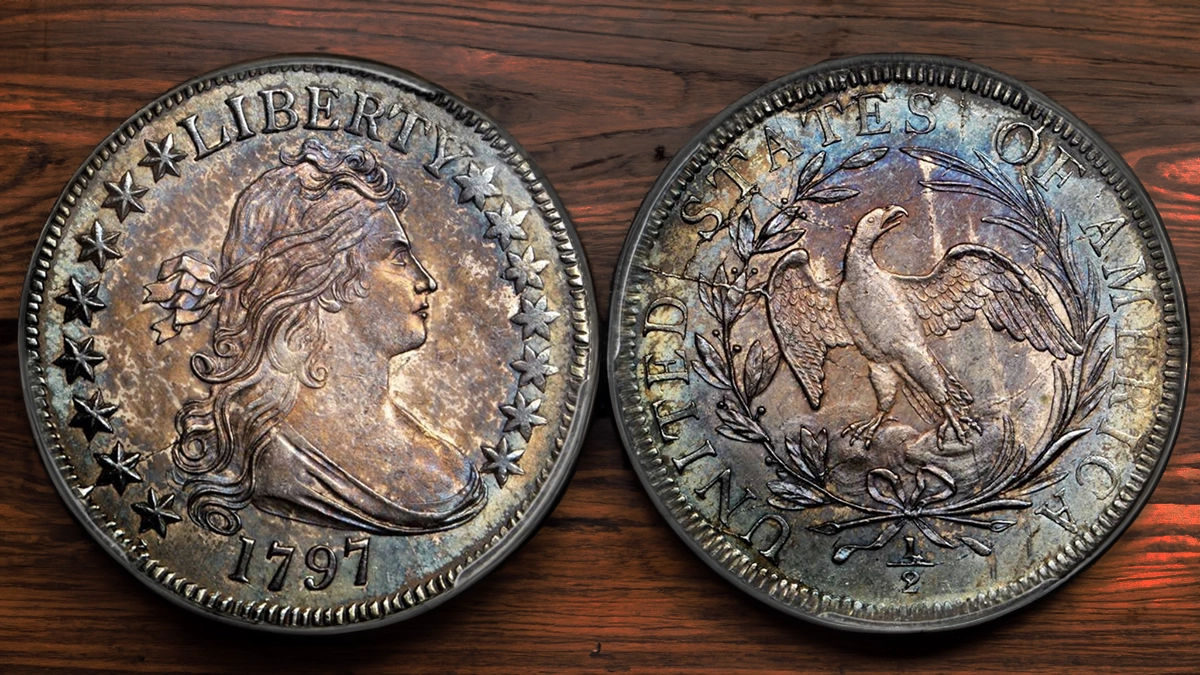
The Draped Bust half dollar was introduced after only two years of production of the previous design. The simple portrait of Liberty on the Flowing Hair type (1794-95) was criticized as inappropriate and not dignified, with her wildly flowing hair more aboriginal than aristocratic. The eagle was especially vilified; one letter writer compared it to a “turkey cock.”
When Henry William DeSaussure replaced the polymath David Rittenhouse as United States Mint Director, he wanted to improve the designs of all coins, particularly the silver issues. DeSaussure was to resign after just five months as director, and his successor Elias Boudinot (former president of the Continental Congress) was in place by the time the revised half dollar was issued. The Draped Bust design was first used on the silver dollar in 1795 and then applied to the cent, the half dime, the dime, the quarter dollar, and the half dollar in 1796.
Draped Bust half dollars of 1796 and ’97 are considered the rarest circulation strike U.S. silver coins. Most bullion depositors at the Mint in the late 1790s requested silver dollars; half dollars were struck only upon specific request. Few were made, very few were preserved as keepsakes, and most today survive in circulated condition. Half dollars of 1796 have both 15-star and 16-star obverses (the 16th star representing the addition of Tennessee to the Union), with the 15-star variety produced first. Paradoxically, half dollars from 1797 also have 15 stars, likely from an obverse die prepared in 1796, to which the last date digit was added for the 1797 production.
The most common half-dollar of this type is the 1797 issue, but “common” in this case is a relative term. All examples of the type are rare and very expensive at the lower grades and extremely expensive, such as very fine or finer. The 1796 16 Star examples are more expensive than the other issues at all grades. No Proofs are known, but a 1796 15 Star coin has been certified as a Premium Gem specimen example.
Varieties
Two major varieties of the 1796 issue are known, one with 15 obverse stars (likely produced first) and the other with 16 obverse stars. Other varieties with minor differences in device placement or size are also known.
CoinWeek Coverage of the Small Eagle Draped Bust Half Dollar
CoinWeek contributor Greg Reynolds discusses the Rogers-Foxfire-Pogue 1797 Draped Bust Small Eagle half dollar and surveys several of the other finest known examples of the type.
In the video above, CoinWeek’s David Lisot interviewed numismatist Jon Amato at the 2013 Central States Convention about Amato’s book, The Draped Bust Half Dollars of 1796-1797.
Design
Obverse:
The obverse prominently displays Liberty in the center of the coin, long flowing hair swept backward and down her neck and tied at the back with a ribbon. Folded drapery is placed across the bust and over her shoulder. Six-pointed stars, LIBERTY at the top, and the date at the bottom form a circle inside the denticled rim. The earlier 1796 variety has 15 stars, eight to the left and seven to the right, and the second version displays 16 stars, nine to the left and seven to the right. The 1797 issue reverts to 15 stars, eight to the left and seven to the right.
Reverse:
The reverse has in the center a right-facing eagle, slightly smaller than on the Flowing Hair type, perched on what appear to be clouds. Around the eagle is a circle formed by two branches, laurel on the left and palm on the right, tied at the bottom with a bow. Below the bow is the denomination, represented as the fraction 1/2 (with a horizontal separator), the only time the denomination is so displayed on any lettered-edge half dollar. UNITED STATES OF AMERICA forms nearly a complete circle inside the denticled rim. All coins were produced in Philadelphia and have no mint mark.
Specifications
| Draped Bust Half Dollar, Small Eagle | |
| Years Of Issue: | 1796-97 |
| Mintage: | 3,918 total mintage for the entire type |
| Alloy: | 89.24% silver and 10.76% copper |
| Weight: | ±13.48 g |
| Diameter: | ±32.50 mm |
| Edge: | Lettered: FIFTY CENTS OR HALF A DOLLAR (words separated by circle, rectangle, or star ornamentation) |
| OBV Designer: | Robert Scot and John Eckstein |
| REV Designer: | Robert Scot and John Eckstein |
* * *
References
Bowers, Q. David. The Experts Guide to Collecting & Investing in Rare Coins. Whitman Publishing.
–. A Guide Book of United States Type Coins. Whitman Publishing.
Breen, Walter. Walter Breen’s Encyclopedia of U.S. Coins. Doubleday.
Guth, Ron, and Jeff Garrett. United States Coinage: A Study by Type. Whitman Publishing.
Parsley, Donald L. United States Early Half Dollar Die Varieties, 1794-1836. Donald L. Parsley.
Taxay, Don. The U.S. Mint and Coinage. Arco Publishing.
Yeoman, R.S and Kenneth Bressett (editor). The Official Red Book: A Guide Book of United States Coins. Whitman Publishing.
* * *





I have a 1797 half dollar drapped bust coin in excellent do know of any buyers.